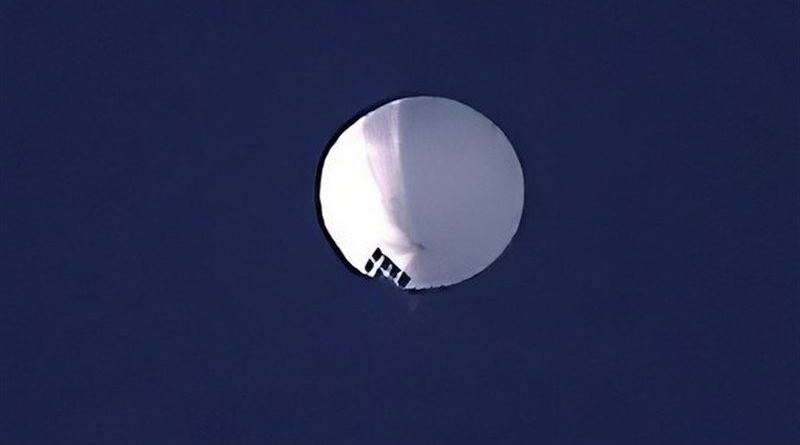China Is Monitoring Its Enemies On The Cheap With Spy Balloons – Analysis
By Observer Research Foundation
By Kartik Bommakanti
The recent missile destruction of a Chinese spy balloon off the Atlantic coast of the United States is part of the People’s Republic of China’s (PRC) extensive aerial surveillance programme. Now a Washington Post report has cited US officials that India was also among several countries in China’s neighbourhood to have been targeted. It is a well-known but not considered an ingenious method to conduct sophisticated surveillance operations. However, why use balloons when China has super-advanced satellites to conduct surveillance missions against its adversaries?
Why Use Balloons?
The rationale for balloon-based surveillance is not novel, but it is fairly simple. Balloons of the kind shot down by the US enable the Chinese to conduct precision surveillance against especially static or land based facilities ranging from military bases, missile launch and radar installations to command and control centers. These surveillance missions can also be conducted against slow-moving targets such as surface vessels across the ocean.
Notwithstanding their seeming innocuousness, the advantages of using balloons are several. Firstly, a balloon of the kind the Chinese used moves very slowly and had a substantial solar array and instrumentation weighing roughly a tonne, geared towards detecting electronic emissions, microwave emissions, radar signals and collecting photographic intelligence.
The slow movement of the PRC’s inflatable object carrying significant detection and intelligence collection equipment gave it considerable loiter time over a target area allowing it to pick up Signals Intelligence (SIGINT) against specific targets. The extended loiter time of the balloon given its low altitude and proximity to the earth’s surface helps geolocation of targets with great precision and map communications, emissions, and signal patterns effectively.
Where Satellites Pale
In a nutshell, the quality of the data and information captured would be very high. All the information and surveillance data gathered by the Chinese is likely to help them in wartime in identifying targets with precision against continental United States. This is where the PRC’s spy balloon has great strengths, contrasting with a satellite whose loiter time is far shorter than a balloon over a specific target area of the earth’s surface whether over land or sea.
Satellites travel at more than 20,000 kilometres per hour giving them very little or limited dwell time over a geographic area even when they are used in clusters following each other in short order. A satellite once detected is easily trackable because its orbital trajectory is fixed. Hence the high orbital velocities of spacecraft combined with their fixed orbital path negate some of the real time advantages that a balloon can offer.
Detecting Balloons Difficult
Thirdly, detecting these balloons is not easy and by the time they have been detected and neutralised, the balloons may have already picked up and transferred data to the host or owner. Very critically, balloons can be fitted with small motors allowing their flight path to be altered moving erratically making them very hard to detect. Finally, they are very cheap to make and if they are destroyed, they are unlikely to cost the owner significantly.
There were already confirmed several balloon missions flown by the Chinese over American territory prior to the latest episode under both the Biden and the Trump Administrations. How damaging these missions were, including the latest, is hard to fully ascertain.
Implications For India
What are the implications of China’s spy balloon for India? There are troubling and disturbing consequences for New Delhi in the face of the PRC’s spying activity using aerial surveillance. If the US has had trouble detecting a slow-moving airborne surveillance object like a balloon, then New Delhi is likely to have already been the target of many of these balloon espionage missions, which went undetected or were detected until it was too late.
India faces more disadvantages. It is believed that the Chinese have sent balloons to Andaman and Nicobar (A&C) islands and it is unclear what India did about it. It is very likely New Delhi discovered them too late and could not do much. Consider what General Glen VanHerck who is the chief of the US North American Aerospace Defence Command (NORAD) said: “As NORAD commander, it’s my responsibility to detect threats to North America. I will tell you that we did not detect those threats. And that’s a domain awareness gap that we have to figure out.”
This is a telling statement, because it reveals why the US, which is the most advanced aerospace power cannot detect something as rudimentary as balloon movement. This means India faces a tall order and no easy solutions. In order to detect China’s spy balloons, India will need considerably higher airborne surveillance assets such as drones and balloons of its own. India could also launch spy balloons of its own into Chinese territory giving its armed forces much needed SIGINT against Chinese targets. Hence, India could and must do to the PRC what the latter is doing to India, if it is not already.
This article originally appeared in Moneycontrol.

